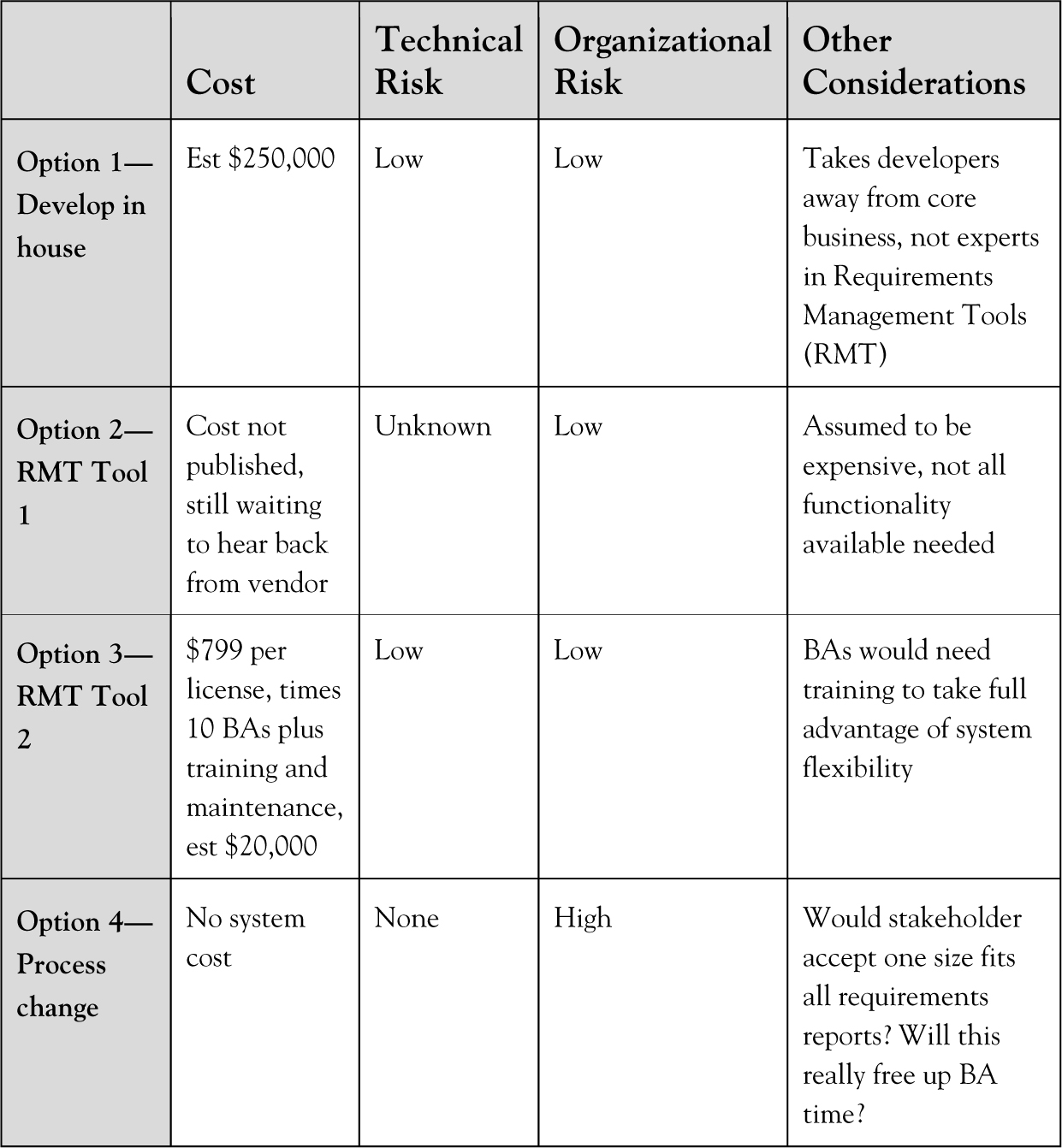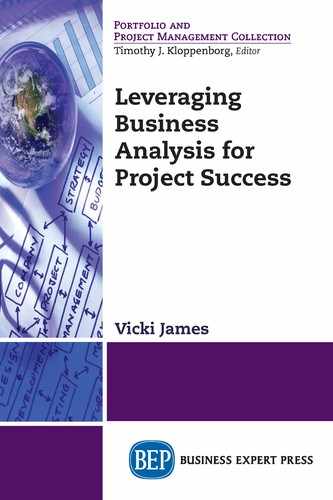Business analysis begins with analyzing the organization’s need and options to aid in selecting and funding projects that will bring the greatest value to the business.
Determine Need
Your business analyst works with the business owner to fully understand the opportunity or problem and provide an objective analysis to define the business need. Often, business owners will identify a solution without first understanding the need. I bet you can come up with at least three examples in your own experience. These are sometimes referred to as “shiny objects”. The result is money invested in tools or solutions that may not do anything to improve or bring value to the business. That is a common result when the need is not identified first. Shiny objects are a waste of money.
The business analyst will work with the business owner to understand what problem needs to be solved, or what opportunity should be leveraged. This will drive all future project decisions. We can look at feature requests and ask, “does it contribute to solving the problem, or aid in pursing the opportunity?”
I had worked with one Chief Information Officer (CIO) who had seen a demonstration of an enterprise portfolio management system. She was so impressed with the system that she said in a large staff meeting, “It does everything except slice bread”. The trouble with these investments is that they are usually very large and are not initiated to address a specific goal. Being an enterprise system means that there are a multitude of capabilities and functions available for use, and also that they are very expensive. In order to make this investment beneficial, you must first determine what business problem you are attempting to solve, or the specific opportunity you hope to leverage, as the project objective. Once the project objective has been established, identify the features and functions, configuration requirements, organizational process changes needed, and user readiness requirements that support that objective. You’ll often see where outside consultants specializing in integration are hired in order to get to the organization ready; plan, configure, and implement the enterprise solution. The cost of the system combined with the cost of a hired consultant may exceed the overall value of the solution.
I recently had dinner with a friend who is now in this organization. I had mentioned the “slicing bread” quote in our conversation, and she knew exactly what I was talking about. Although she was not yet in the organization at the time, the legend of the statement lives. I asked where the solution is today. As it turns out, the solution is no longer used, the data it houses is now stale and unused, yet the organization has not yet pulled the plug. I am unsure of the licensing and operational costs associated with keeping the current solution, but it certainly exceeds the value the solution provides. That is one expensive shiny object.
Let’s look at how this scenario might play out in one of your projects. The following is a section of the case study that we will be reviewing through this chapter to better understand the context of the chapter points.
Weaver Systems provides medical management information systems to health care organizations. MyTx is their signature product that allows medical providers and patients to share information through a secure web solution. Ideas of system enhancements come fast and furious from medical providers and patients alike. Core system enhancements and subsystems are released several times a year.
The business analysts at Weaver Systems have a difficult time keeping up with the changing requirements and associated workload, and as a result, project requirements suffer. Liz, the business analyst assigned to this specific issue, has investigated the issue and come to understand that the business analysts spend a significant amount of the project time duplicating requirement information from one document to another in order to satisfy the different audiences for requirements. Time to create information on the requirements can take five times longer than eliciting the requirements themselves. This means less time for requirements analysis, which resulted in more missed and wrong requirements in recent projects. They have also seen a rise in confusion among project stakeholders as to which document/requirement is correct and current.
Weaver Systems needs a better way to record, manage, communicate, and update requirements so that requirements can be captured once and then managed and communicated efficiently.
Evaluate Options
Now that the need is understood, the business analyst can begin to work on understanding what capabilities the organization already has. For example, if your organization is looking at project portfolio solutions but already has Microsoft Project Server, then no additional tool investment may be needed. Or perhaps SAP is a commonly used solution in your organization. The business analyst may determine that adding additional functionality would be a lower cost alternative and that transition and training time would be minimal in expanding technology already available within the organization. This speaks to the approach that the organization will use to address the opportunity or problem being addressed.
Analysis is needed to understand the best approach for implementing a solution. The business analyst will prepare analysis for several different options to provide full information and a recommendation to decision makers. The costs associated with the various options include looking at the development, implementation, training, and maintenance costs of one or more solutions to understand the long-term impacts. This is your first big opportunity to save money and increase the value to the organization. Let’s see how this plays out in our case study.
After getting agreement from the business analysts and the management team on the problem, Liz set out to understand what some options might be to alleviate the problem.
Option 1 Tom, the development manager, has offered to get some of his finest developers up to work on developing a new system to manage requirements. He estimates that it will take 6 months and $250,000 to complete the project.
Option 2 Liz remembers a demonstration she had seen of a very sophisticated requirements management tool at a recent IIBA chapter meeting. It was very fancy, and some of the demonstrated functionality went way beyond solving the stated problem, but could come in handy in the future.
Option 3 Liz found a requirements management tool on line that didn’t look as sophisticated as the demo she had previously seen. Based on the product website, it would address the problem identified.
Option 4 Liz’s boss, Megan, doesn’t feel any technology solution is needed. Instead, Megan feels the processes and organization expectation need to change so that requirements documents can be developed once, and shared the same across all stakeholder groups.
Liz spent some additional time analyzing each of the options to develop the following analysis:

Figure 8 Example of Options Analysis
Once the problem and several options have been identified, the business analyst can now start making the case for the most feasible and attractive solution. The business case is a request for resources and time to complete the project. The business analyst will work with the business to complete the business case on behalf of the business. The business case should represent the solution that the business wants to invest in.
A business case will contain many or all of the following elements.
• Business Need/Rationale
• Recommendation
• Solution Deliverables
• Feasibility Analysis
• Alternatives Considered
• Risk Assessment
• Cost-Benefit Analysis
• Implementation Approach
• Evaluation Measures (how will we measure the effectiveness of the solution)
These business case sections scream of “analysis” needed to put together a comprehensive business case that will provide enough information to make a good investment decision, a fact that Project Management Institute (PMI) agrees with, as evidenced in the PMBOK® Guide v. 5: “Typically, the business need and the cost-benefit analysis are contained in the business case to justify and establish boundaries for the project, and such analysis is usually completed by the business analyst using various stakeholder inputs.”
Who creates the business case in your organization? This is one area where it may not be a person with the title of “business analyst”, but rather another role doing the business analysis activities. The only caution here is that this individual knows, understands, and applies best practices in developing the business case. Without the analysis, especially as it relates to comparing different options, you may have a request for funding, but not a business case. “CEO Jones wants to spend $250,000 in the XYZ tool because it’s cool” is not a business case. Let’s take a look at a better example.
Business Need: Weaver Systems needs a better way to record, management, communicate, and update requirements so that requirements can be captured once and then managed and communicated efficiently.
Recommendation: Implement the second requirements management tool (Option 3).
Solution Deliverables:
• Off-the-shelf requirements management tool installed/implemented
• Customizable data entry screen
• Customizable reports
• Solution training for BAs
Alternatives Considered: See Figure 8

Figure 9 Example of Cost-Benefit Analysis
Assumptions: It is assumed that value realized from projects will be gained from having more time to do quality analysis. This time to do analysis will allow us to implement solutions that impact the organization bottom line with real returns as evidenced by less rework resulting from missed or poor requirements.
Evaluation Measures: The percentage of defects found that can be attributed to poor requirements will be reduced by 50 percent each year.
Business analysts will spend no more than 20 percent of their time preparing requirements documents within 18 months after implementation.
For the selected project …
1. What was the business problem or opportunity that the project was initiated to address?
2. Is the project on track to address this problem or leverage the opportunity?
3. What were the options considered to address the problem?
4. What will you do different for the next project?
